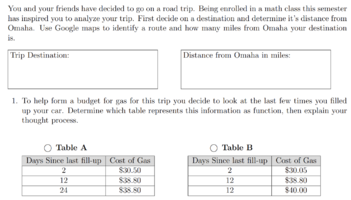You are using an out of date browser. It may not display this or other websites correctly.
You should upgrade or use an alternative browser.
You should upgrade or use an alternative browser.
Planning a trip
- Thread starter NiaWilson
- Start date
I just need to be walked through it.View attachment 33992
Please don't make me feel stupid, but I chose table A, because on table B does not make sense. I then started to second guess my answer.
Dr.Peterson
Elite Member
- Joined
- Nov 12, 2017
- Messages
- 16,861
Presumably they do expect A as the answer; that's because of the definition of function, which is the key word in the problem. Do you know that definition? What it says is that for a function, the output is determined by the input, in the sense that if you put in the same input twice, you will get the same output each time. Do you see how B doesn't fit that definition, but A does? I'm guessing that may be what you mean by "table B does not make sense".View attachment 33992
Please don't make me feel stupid, but I chose table A, because on table B does not make sense. I then started to second guess my answer.
On the other hand (and this is why I am telling you more than we normally would), the question as a whole doesn't make much real sense. Although table A does represent a function, table B is entirely possible in reality, because the cost of a fill-up doesn't really depend only on the number of days that have elapsed -- that is, we wouldn't really expect cost to be a function of elapsed time. If table A were real, the fact that you can have the same cost of gas under two different situations provides an example: Perhaps they used the same amount of gas over two periods of different lengths, because they drove differently those two days. Cost is a function of elapsed time and other things! And table B is possible because the price of gas might have changed, or, again, they might have driven differently over the second 12-day period, and used more gas.
My point is that this is not a realistic problem; in answering it (and others to come, I imagine), you will need to set aside knowledge of the real world, and just look at the data as if it had no meaning. Given a table like this, you can tell if it "represents a function" merely by looking at the numbers and observing that a function can't have the same number twice as an input with different outputs, but can have the same number twice as an output, for different inputs. Just apply the definitions you are being taught.
So, no, you aren't stupid; you're smarter than they think you are. On the other hand, "second guessing" can be a good thing in math. I always look at my answers twice, to make sure I didn't do something ... well, stupid. (We all do that.)

